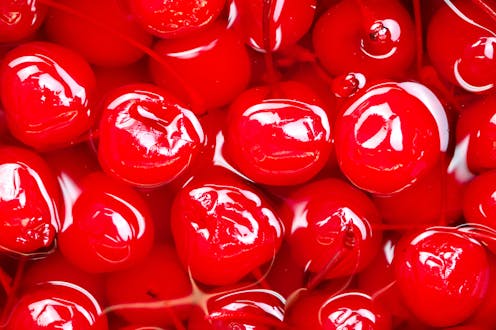FDA bans Red 3 dye from food and drugs – a scientist explains the artificial color’s health risks and long history
- Written by Lorne J. Hofseth, Professor and Associate Dean for Research, College of Pharmacy, University of South Carolina

Red 3 – also called FD&C Red No. 3, erythrosine or E127 – has been widely used in food, cosmetics and pharmaceuticals since its FDA approval in 1969[1]. You’ve likely encountered Red 3 before. It’s a common additive to many candies, beverages, baked goods, cereals, maraschino cherries and gelatin desserts, as well as certain medications, syrups and cosmetics.
However, mounting scientific evidence suggests that consuming Red 3 poses significant health risks. These risks prompted California to ban its use[2] in food in 2023 and the Food and Drug Administration to ban[3] its use in both food and pharmaceuticals nationwide on Jan. 15, 2025.
As a researcher studying inflammation and cancer[4], I investigate how synthetic food dyes affect human health. Stricter regulations reflect growing concerns over the negative physiological effects of Red 3 and other synthetic dyes on your body, including causing cancer.
Health risks of Red 3
Over the past 35 years, an increasing amount of scientific evidence[5] has identified the negative health effects of Red 3. While researchers haven’t yet established a direct link between Red 3 and cancer in people, substantial evidence from animal studies points to its carcinogenic potential.
First, Red 3 disrupts thyroid hormone regulation[6] through several mechanisms. It inhibits the thyroid gland’s ability to absorb iodine[7], a key component for synthesizing thyroid hormones, and blocks an enzyme essential[8] for converting one thyroid hormone to another, contributing to thyroid dysfunction[9]. Along with other impairments in thyroid hormone function[10], Red 3 increases the risk of thyroid-related disorders.
Second, Red 3 may promote thyroid tumor formation. Several studies[12] exposing[13] rats[14] and pigs[15] to Red 3 observed enlarged tumorous thyroid glands and abnormalities in hormone regulation.
Third, Red 3 can have toxic effects on the brain in multiple ways. Rat studies have found that this synthetic dye increases oxidative stress[16], which damages tissues, and reduces the antioxidants that control oxidative stress, impairing communication between neurons. Studies in rodents also found that Red 3 triggers neuroinflammation[17] that leads to neuronal damage and dysfunction. Additionally, Red 3 may interact with the amyloid-beta peptides[18] linked to neurodegenerative conditions like Alzheimer’s disease and worsen those conditions.
Regulatory momentum
Red 3 first faced scrutiny in the 1980s when several animal studies linked it to[19] thyroid tumors[20] in male rats[21]. This led to its 1990 ban in cosmetics[22] in the U.S., although its use in food persisted under industry pressure. While the European Union[23] restricted the use of Red 3 to only certain types of processed cherries in 1994, the U.S. has lagged behind.
California’s 2023 ban of Red 3[24] in foods, effective in 2027, reignited debate on Red 3 and its link to cancer and spurred 24 organizations[25] to advocate for federal action.
Several countries have banned the use of Red 3 in food. Until January 2025, the U.S. had only banned it in cosmetics and topical drugs.This debate culminated in the FDA’s nationwide ban in January 2025[26]. While the FDA cites no direct evidence of Red 3’s carcinogenic effect in people, it acknowledges that animal studies provide sufficient basis for regulatory action. The FDA’s decision aligns with the 1958 Delaney Clause[27] of the Federal Food, Drug and Cosmetic Act, mandating a ban on additives shown to cause cancer in humans or animals.
Notably, it took over 35 years from the initial findings of thyroid cancer in rodents to the eventual ban in 2025.
A path forward
The progression from Red 3’s approval to its prohibition highlights the conflict between industrial interests and public health. Continued vigilance over Red 3 could help the nation prioritize consumer safety.
Under the FDA’s mandate, manufacturers must reformulate food products and ingested drugs[28] to leave out Red 3 by January 2027 and January 2028, respectively. While some countries still permit use of Red 3, U.S. imports must meet domestic safety standards. Harmonizing global standards on regulating and evaluating synthetic dyes is essential to protect consumer health.
Several companies selling ultra-processed foods have begun the shift away from synthetic dyes. In 2016, Mars announced plans[30] to remove all artificial colors from its human food products over a five-year period. In 2024, General Mills announced[31] that it would eliminate artificial colors and flavors from its products.
Consumers can protect themselves from Red 3 exposure by reading ingredient labels for “FD&C Red No. 3” or “E127” and choosing products that use natural dyes. Preparing homemade foods with natural color alternatives like beet juice or turmeric is another option. Supporting dye-free brands and staying informed about regulatory changes can further reduce your exposure while promoting safer food practices.
Ongoing research and policy reforms focused on public safety could help ensure that food additives like Red 3 no longer put consumer health at risk.
References
- ^ FDA approval in 1969 (www.fda.gov)
- ^ California to ban its use (www.npr.org)
- ^ Food and Drug Administration to ban (www.fda.gov)
- ^ inflammation and cancer (scholar.google.com)
- ^ increasing amount of scientific evidence (doi.org)
- ^ disrupts thyroid hormone regulation (doi.org)
- ^ absorb iodine (doi.org)
- ^ enzyme essential (doi.org)
- ^ thyroid dysfunction (doi.org)
- ^ impairments in thyroid hormone function (doi.org)
- ^ Marat Musabirov/iStock via Getty Images Plus (www.gettyimages.com)
- ^ Several studies (doi.org)
- ^ exposing (doi.org)
- ^ rats (doi.org)
- ^ and pigs (doi.org)
- ^ increases oxidative stress (doi.org)
- ^ triggers neuroinflammation (doi.org)
- ^ interact with the amyloid-beta peptides (doi.org)
- ^ linked it to (doi.org)
- ^ thyroid tumors (doi.org)
- ^ in male rats (doi.org)
- ^ 1990 ban in cosmetics (www.fda.gov)
- ^ European Union (doi.org)
- ^ California’s 2023 ban of Red 3 (www.npr.org)
- ^ 24 organizations (www.cspinet.org)
- ^ nationwide ban in January 2025 (www.fda.gov)
- ^ 1958 Delaney Clause (www.fda.gov)
- ^ reformulate food products and ingested drugs (www.fda.gov)
- ^ choness/iStock via Getty Images (www.gettyimages.com)
- ^ Mars announced plans (www.mars.com)
- ^ General Mills announced (www.bloomberg.com)
Authors: Lorne J. Hofseth, Professor and Associate Dean for Research, College of Pharmacy, University of South Carolina




